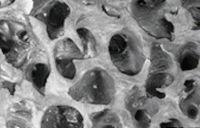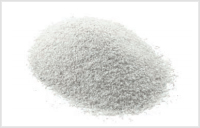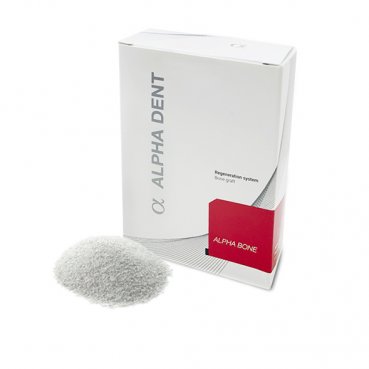No products
To be determined
Shipping
0,00€
Total
Product successfully added to your shopping cart
Quantity
Total
There are 0 items in your cart.
There is 1 item in your cart.
Total products
Total shipping
To be determined
Total
AlphaBone 1-2mm (0.5g 1.25cc)
DIG102005
Alphabone is produced by combining a bovine mineral bone matrix with bioactive resorbable polymers and collagen fragments.
Alphabone is completely resorbed and replaced by the patient’s own bone within 1-2 years. Alphabone is extremely biocompatible and is fully compliant with CE and ISO 10993-1 requirements.
Made in Switzerland
Alphabone is completely resorbed and replaced by the patient’s own bone within 1-2 years. Alphabone is extremely biocompatible and is fully compliant with CE and ISO 10993-1 requirements.
Made in Switzerland
KEY FEATURES
Alphabone is a new hybrid bioactive bone substitute specifically developed for bone regeneration in reconstructive surgery. Alphabone is produced by combining a bovine mineral bone matrix with bioactive resorbable polymers and collagen fragments. This new concept of composite biomaterial promotes a quick growth of the patient’s cells into Alphabone while its biopolymers degrade, providing perfect integration and osteogenesis.


PERFECT FIT:
• Regeneration of periodontal bone defects
• Regeneration of extraction alveoli
• Regeneration of cavities between the alveolar wall and immediate implants
• Horizontal alveolar ridge augmentation
• Sinus lift floor elevation
• Alveolar ridge augmentation at implant sites with sufficient residual bone and a good blood supply
ADVANTAGES OF ALPHABONE:
• Easy dust free shaping with any type of surgical tool (for example: bone cutter, drill)
• Resistant to extreme loads and to heavy surgical maneuvering
• Far better stability of the augmented bone graft vs the loose granules
• Bigger defects do not need autologous bone, thus reducing patient morbidity avoiding a second surgical site
• No resorption: the polymeric coating protects the graft during initial healing/osseointegration period
• Readily absorbs blood
DO:
• Prepare the receiving site well
- properly expand soft tissues
- properly microdrill native bone
• Ensure a tight contact to host bone
- appropriate graft shaping
- firmly tight screws
• Smooth edges and corners
• Use membrane to cover Alphabone Microchips (suggested collagene or pericardium membrane)
DON’T:
• Avoid the use of saline solution, mix it with patient blood
• Do not overfill (avoid extra material, it does not shrink)
• Do not mix it with other biomaterials
• Do not reuse the product
• Do not re-sterilise

FAQs
• Where is Alphabone produced?
Alphabone production is located in Switzerland.
• What is Alphabone made of?
It’s a composite material, made of a bovine derived mineral matrix, reinforced with biopolymers and proteins.
• Where does the bovine derived mineral matrix of Alphabone come from?
We supply our production with bovine derived tissues directly from fully certified companies in New Zealand, a “BSE negligible risk Country” (formerly known as “BSE free Country”). We control all our supply chain, according to the most strict norms and highest quality standards, according to the EU Regulation 722/2012 and ISO 22442.
• Which biopolymers are used?
We use biodegradable polymers, the same used in resorbable sutures.
• Which is the expected (average) time of resorption of the biopolymers present within Alphabone?
They are degraded and resorbed in about 4-6 months: meanwhile they degrade and get resorbed, newborn bone is formed.
• Is Alphabone hydrophilic?
Yes. Due to its composition Alphabone is extremely hydrophilic and can sustain a 38% w/w (av.) swelling in physiologic fluids. This features allow the graft to quickly and massively absorb blood once in situ, hence sparkling a better and faster integration with the host tissue.
• Can the biomaterial be mixed with a saline solution?
The saline solution is not a fundamental component involved in the regeneration biological process, for this reason the patient’s blood is absolutely recommended. The saline solution could extract the proteins addicted onto the trabecular surface of the graft.
• Do I need to use a membrane?
The use of the membrane is recommended in oral surgery, e.g. in cases of horizontal augmentations, in order to protect the graft from any dehiscence.
• What’s the biological mechanism of osseointegration of a bone graft?
Bone generally has the ability to regenerate completely, but it requires a very small fracture space or some sort of scaffold to do so. Indeed, bone grafting is possible because bone tissue has the ability to regenerate completely if provided the space into which to grow. As native bone grows, it will generally replace the graft material completely, resulting in a fully integrated region of new bone. The biologic mechanisms that provide a rationale for bone grafting with composite grafts and xenografts are osteoconduction (guiding the reparative growth of the natural bone) and osteoinduction (encouraging undifferentiated cells to become active osteoblasts). Only few bone grafts ensure a complete remodeling, Alphabone is among these, together with autografts.
• Once the vial or envelope has been opened, can I close it again, re-sterilise it and, if necessary,
within what period of time should I use it?
No, once the primary packaging has been opened (in a sterile surgical environment), the material must be used immediately on a single patient. The surplus material must be disposed of according to IFU. ALPHABONE IS SINGLE USE.
• Why is Alphabone single use?
Alphabone provided, in its intact packaging, as a sterile medical device; once opened, it must be used immediately. Storage after opening does NOT ensure safety! Alphabone is, hence, single use.
• Can I keep the material in the fridge?
The material must be stored according to the instructions on the labels, therefore away from light or heat sources, in a dry place and between +2 and +25°C.
Alphabone is a new hybrid bioactive bone substitute specifically developed for bone regeneration in reconstructive surgery. Alphabone is produced by combining a bovine mineral bone matrix with bioactive resorbable polymers and collagen fragments. This new concept of composite biomaterial promotes a quick growth of the patient’s cells into Alphabone while its biopolymers degrade, providing perfect integration and osteogenesis.


| Reference | Product name | Sizes | Volume | U/g |
| ADBL05. | AlphaBone 0.25-1mm (0.25g; 0.45cc) | 0.25 - 1 mm | 0,45 cc | 0,25 g |
| ADBL10. | AlphaBone 1-2mm (0.5g; 1.25cc) | 1 - 2 mm | 1,25 cc | 0,5 g |
| ADBL20. | AlphaBone 1-2mm (1g; 2.5cc) | 1 - 2 mm | 2,5 cc | 1 g |
| ADBL50. | AlphaBone 1-2mm (2g; 5cc) | 1 - 2 mm | 5 cc | 2 g |
PERFECT FIT:
• Regeneration of periodontal bone defects
• Regeneration of extraction alveoli
• Regeneration of cavities between the alveolar wall and immediate implants
• Horizontal alveolar ridge augmentation
• Sinus lift floor elevation
• Alveolar ridge augmentation at implant sites with sufficient residual bone and a good blood supply
ADVANTAGES OF ALPHABONE:
• Easy dust free shaping with any type of surgical tool (for example: bone cutter, drill)
• Resistant to extreme loads and to heavy surgical maneuvering
• Far better stability of the augmented bone graft vs the loose granules
• Bigger defects do not need autologous bone, thus reducing patient morbidity avoiding a second surgical site
• No resorption: the polymeric coating protects the graft during initial healing/osseointegration period
• Readily absorbs blood
DO:
• Prepare the receiving site well
- properly expand soft tissues
- properly microdrill native bone
• Ensure a tight contact to host bone
- appropriate graft shaping
- firmly tight screws
• Smooth edges and corners
• Use membrane to cover Alphabone Microchips (suggested collagene or pericardium membrane)
DON’T:
• Avoid the use of saline solution, mix it with patient blood
• Do not overfill (avoid extra material, it does not shrink)
• Do not mix it with other biomaterials
• Do not reuse the product
• Do not re-sterilise

FAQs
• Where is Alphabone produced?
Alphabone production is located in Switzerland.
• What is Alphabone made of?
It’s a composite material, made of a bovine derived mineral matrix, reinforced with biopolymers and proteins.
• Where does the bovine derived mineral matrix of Alphabone come from?
We supply our production with bovine derived tissues directly from fully certified companies in New Zealand, a “BSE negligible risk Country” (formerly known as “BSE free Country”). We control all our supply chain, according to the most strict norms and highest quality standards, according to the EU Regulation 722/2012 and ISO 22442.
• Which biopolymers are used?
We use biodegradable polymers, the same used in resorbable sutures.
• Which is the expected (average) time of resorption of the biopolymers present within Alphabone?
They are degraded and resorbed in about 4-6 months: meanwhile they degrade and get resorbed, newborn bone is formed.
• Is Alphabone hydrophilic?
Yes. Due to its composition Alphabone is extremely hydrophilic and can sustain a 38% w/w (av.) swelling in physiologic fluids. This features allow the graft to quickly and massively absorb blood once in situ, hence sparkling a better and faster integration with the host tissue.
• Can the biomaterial be mixed with a saline solution?
The saline solution is not a fundamental component involved in the regeneration biological process, for this reason the patient’s blood is absolutely recommended. The saline solution could extract the proteins addicted onto the trabecular surface of the graft.
• Do I need to use a membrane?
The use of the membrane is recommended in oral surgery, e.g. in cases of horizontal augmentations, in order to protect the graft from any dehiscence.
• What’s the biological mechanism of osseointegration of a bone graft?
Bone generally has the ability to regenerate completely, but it requires a very small fracture space or some sort of scaffold to do so. Indeed, bone grafting is possible because bone tissue has the ability to regenerate completely if provided the space into which to grow. As native bone grows, it will generally replace the graft material completely, resulting in a fully integrated region of new bone. The biologic mechanisms that provide a rationale for bone grafting with composite grafts and xenografts are osteoconduction (guiding the reparative growth of the natural bone) and osteoinduction (encouraging undifferentiated cells to become active osteoblasts). Only few bone grafts ensure a complete remodeling, Alphabone is among these, together with autografts.
• Once the vial or envelope has been opened, can I close it again, re-sterilise it and, if necessary,
within what period of time should I use it?
No, once the primary packaging has been opened (in a sterile surgical environment), the material must be used immediately on a single patient. The surplus material must be disposed of according to IFU. ALPHABONE IS SINGLE USE.
• Why is Alphabone single use?
Alphabone provided, in its intact packaging, as a sterile medical device; once opened, it must be used immediately. Storage after opening does NOT ensure safety! Alphabone is, hence, single use.
• Can I keep the material in the fridge?
The material must be stored according to the instructions on the labels, therefore away from light or heat sources, in a dry place and between +2 and +25°C.








